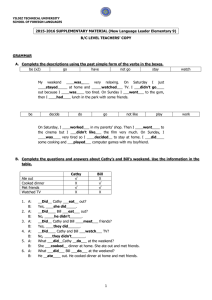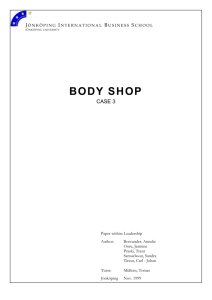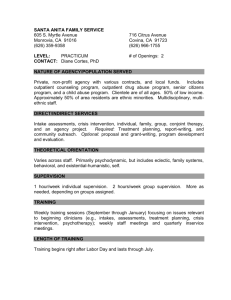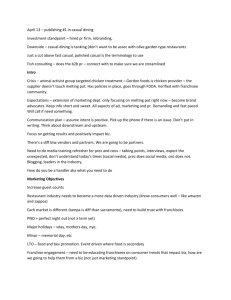Body Shop case
advertisement
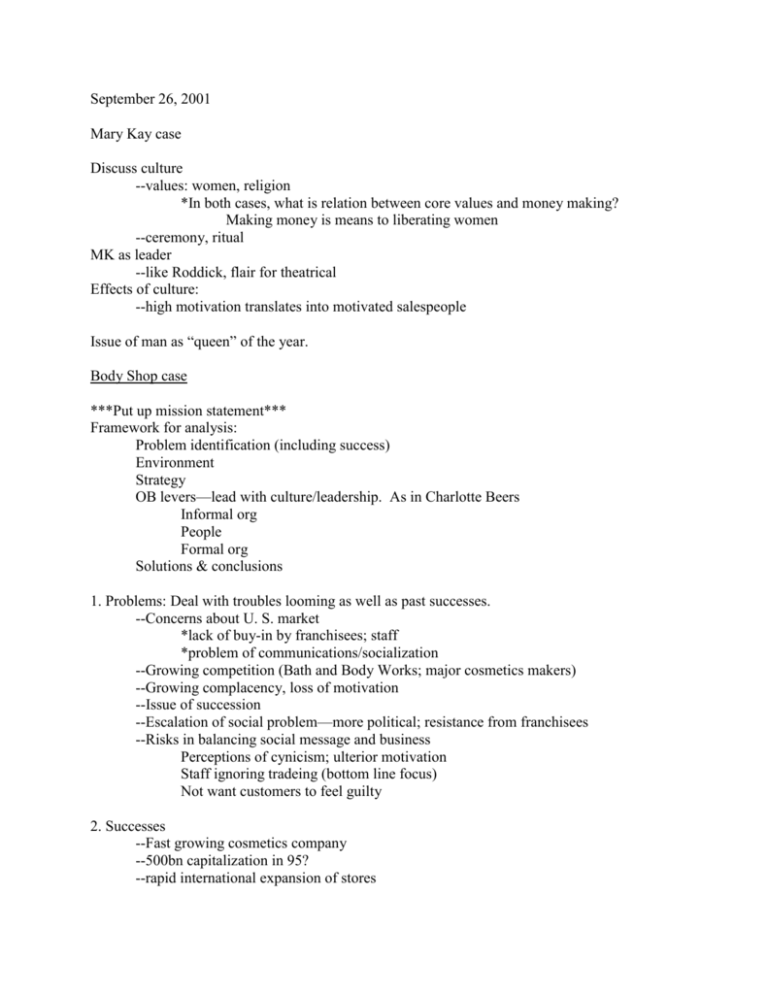
September 26, 2001 Mary Kay case Discuss culture --values: women, religion *In both cases, what is relation between core values and money making? Making money is means to liberating women --ceremony, ritual MK as leader --like Roddick, flair for theatrical Effects of culture: --high motivation translates into motivated salespeople Issue of man as “queen” of the year. Body Shop case ***Put up mission statement*** Framework for analysis: Problem identification (including success) Environment Strategy OB levers—lead with culture/leadership. As in Charlotte Beers Informal org People Formal org Solutions & conclusions 1. Problems: Deal with troubles looming as well as past successes. --Concerns about U. S. market *lack of buy-in by franchisees; staff *problem of communications/socialization --Growing competition (Bath and Body Works; major cosmetics makers) --Growing complacency, loss of motivation --Issue of succession --Escalation of social problem—more political; resistance from franchisees --Risks in balancing social message and business Perceptions of cynicism; ulterior motivation Staff ignoring tradeing (bottom line focus) Not want customers to feel guilty 2. Successes --Fast growing cosmetics company --500bn capitalization in 95? --rapid international expansion of stores 3. Strategy --Low cost—lean operation. Message of simplicity leveraged into lower costs Franchise model Urine bottles Testing on volunteers No marketing department; sales or promotions Source from subcontractors --Bond customers to store through shared values --Highly motivated, well-trained staff --Tight control of franchise operations (cultural in large part) --Differentiate product from cosmetics industry norm *Serve niche of people who dislike conventional cosmetics *No advertising; marketing; educate customer; seek publicity thru attracting media attention to Anita’s causes. PR consultant -Initial success was due to newspaper article re body shop *All natural; healthy products *Low key, helpful staff *Store as “theatre”; attractive environment *Consistency throughout Could a co. with a less “progressive” product succeed with this strategy? (Honda) 4. Culture --Core values (put up mission statement) *Travel; international *Natural, healthful products—different image of beauty *Social responsibility; environment; local community *Innovation (product development, HR) *Eccentricity; quirkiness; break rules *Women; feminine values; emotionality (love, etc.). *Profit with principle; serve stakeholders #Neglect economic? (contrast between corporate mission statement & what Anita has to say) *Business as way of doing good Comm. Development Trade not Aid: Boys Town; Soapworks factory near Glasgow *Negative values Hate bureaucracy; business Particularly European? Disdain for standard business practice --Beliefs: business can be socially responsible and do well Symbols: “Department of damn good ideas?” (DODGI) --Norms: many rules about how people should behave; very politically correct Ceremony? Legends? Emotional labor in headquarters Use of gossip networks? Planting rumors --Consequences of culture for business: *keep staff *attract and keep customers *much publicity *Coordinate/ integrate stores Question of genuineness: --Going public; redoubled efforts. “owe nothing to investors” --animal testing/all natural --Programs themselves: genuine? Or grandstanding. (Boys Town and Glagow plant) 5. Leadership --Is she a visionary? --Is she charismatic (or abrasive) --Is she participatory or authoritarian? --Is she patronizing and exploitative --Passion, commitment --Downside: hard to work with (partnerships with Greenpeace, Friends of Earth) --Naivete (Boys Town situation) So culture and leadership are key OB levers. How about alignment? People: Selection of franchisees—took up to 3 years -Personality test, home visit -Women under 30- youthful idealism, passion; channel this -Franchisees don’t have retailing experience -Committed to culture; loyal to Anita -Intense screening for values (“How like to die?”) Socialization -Training center (not ‘train’ but develop, socialize) -Constant communication with shops (visits,in-house videos; faxes) Express purpose: build culture; sense of difference Paint cosmetic industry as enemy -Role model (jeans, backpack, salty language, loud mouth) Motivate: -Make work meaningful; “Put love where labor is”; -Participation of staff & customers >> commitment Suggestion boxes; bonuses “Red letter” –direct comm. With director -Substitute for market research (cost) Formal organization: Structure High differentiation internationally; decentralization of mgt. -Franchise, but owns 10%. -Used for marketing; product development -Departments for social responsibility Integration -Standardization of product, stores -Head franchisee system -Use of culture and leadership for integration & standardization -Accounting systems; Gordon as business manager -Leaning on franchisees and staff to participate in social responsibility programs—tough issue. Need for consistency, but fair to impose views? Community programs by stores. Systems Good business/accounting systems (Gordon). Anita doesn’t think about it but he does. HR Bonuses for participation; suggestions Bottom-up appraisals Day care center Solutions to problems: -Entering U. S. market need for advertising; malls; less progressive values How much should they change their practices? Difficulty of selection and socialization of U. S. franchisees & staff -Company getting complacent Concern that working for Body Shop enough to be responsible. Hired professional manager in 98; Anita left to become full-time activist. --Too much expansion of stores in U. S. --He introduced line of low-cost products that diluted brand; lost business Annual Report says in late 2000, early 2001, good growth. Stock price about one pound. Takeover by Omni? Fell through for strategic reasons. Analysts: no longer occupied a unique niche. How to succeed in U. S.—become more theatrical? Additional notes: 1. Student who consulted with Mary Kay in Texas said that after she stepped down, the company began doing poorly. But then an outside director was replaced by her son, and he managed by saying “this is what Mother wants done.” They did better after that. When the Body Shop went public, analysts/investors were concerned about the social message.

